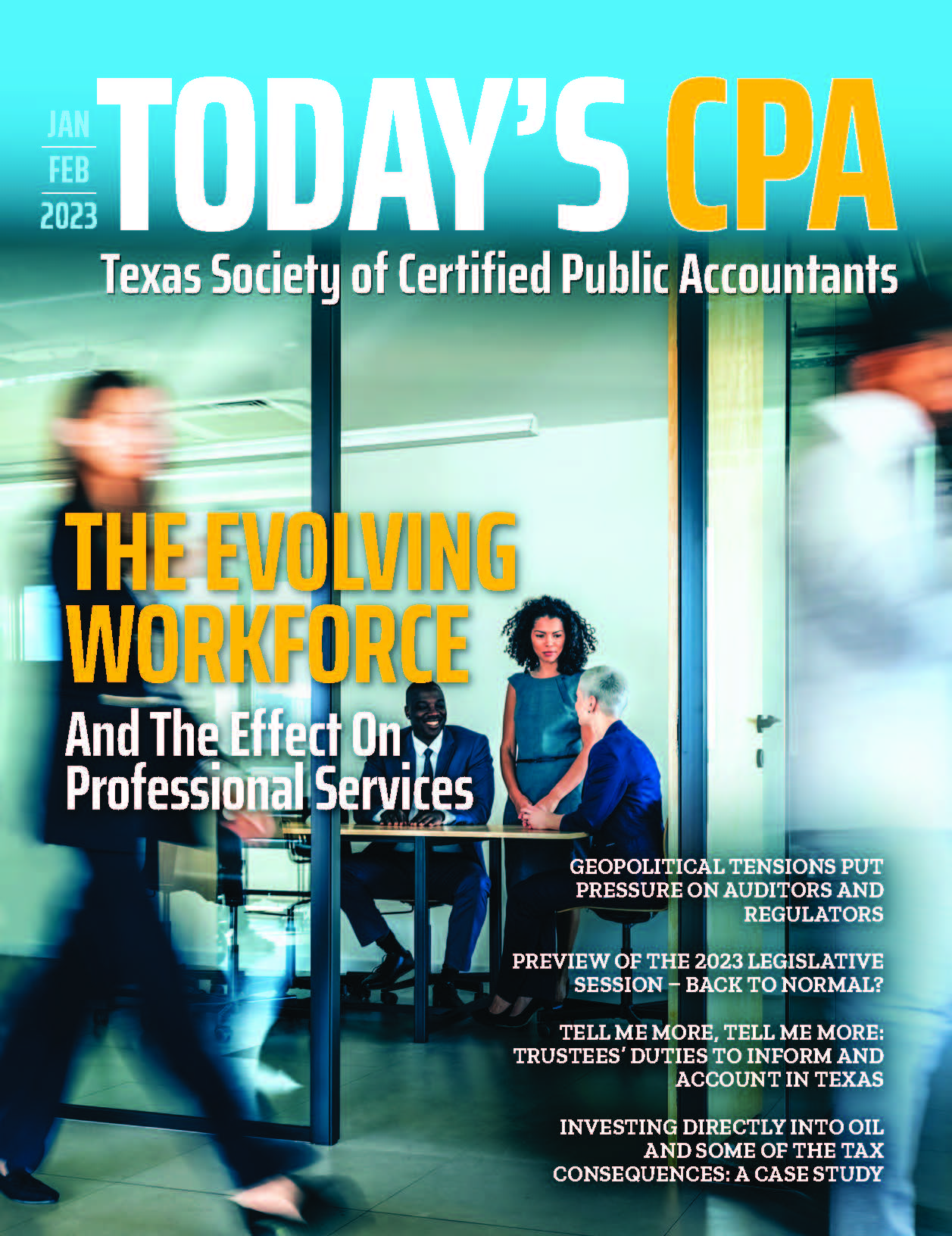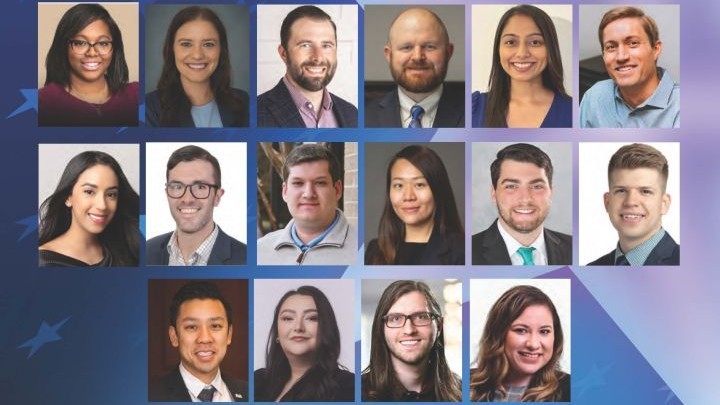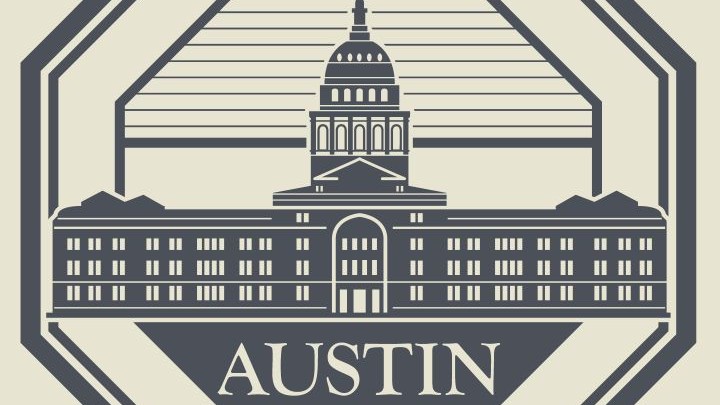The Evolving Workforce and the Effect on Professional Services
By M. Ray Perryman
Job openings in many parts of the United States (including Texas) have been far exceeding unemployment. While potentially beneficial for those looking for work (assuming they have the skills), the shortages are presenting notable challenges. Businesses unable to fill positions are often forced to respond by reducing operating hours or even closing locations, and the economy is functioning at less-than-optimal efficiency.
For perspective, prior to COVID-19, the number of job openings across Texas had never topped 623,000 and were generally well below that level. In February 2020, just before the pandemic, there were 534,000 openings. With the ensuing disruptions, openings dropped to as low as 302,000 (April 2020) before beginning to rise.
By the end of 2020, they were back in pre-pandemic ranges. As the Texas economy continued to gain momentum through 2021, the number of open positions started trending toward 900,000 or even higher. In June (the latest data as I am writing this article), they stood at 988,000. This record escalation comes despite quite rapid hiring in recent months. Texas regained all the jobs lost during the shutdown in only 19 months (15 months or less in some urban centers), compared with 27 months for the nation as a whole.
The pace of expansion and number of openings may moderate given challenges such as inflation, higher interest rates and greater uncertainty on many fronts. In fact, it would be difficult to find enough bodies to fill positions at the recent rate over an extended period. Nonetheless shortages are most assuredly going to persist.
Many factors are contributing to the current labor shortages. Simple demographic reality is one major culprit. Texas is reflecting national trends, with the retirement of the baby boomers coinciding with decisions by younger people to start working later.
TXCPA’s Pipeline StrategyTXCPA’s pipeline strategy was created to assist in growing the profession and expanding the CPA pipeline. The purpose of the pipeline strategy is to effect change and increase the number of individuals becoming licensed CPAs by expanding our outreach to:
We also have a strong commitment to partnering with the many other organizations that are also involved in pipeline initiatives at the state and national levels. Learn more about the pipeline strategy.
|
The so-called “Great Resignation,” where millions of Americans purportedly left the workforce, is also contributing modestly – although far less than many headlines imply. In fact, the workforce participation rate in the working-age population is only slightly below pre-pandemic levels. Much of this current problem would exist even if COVID-19 had never happened.
The bottom line is that we have seen these labor shortages coming for a long time, although the pandemic accelerated things moderately. The underlying demographic patterns are the driving force and they are not changing anytime soon. Strong economic expansion in Texas is obviously also raising labor demand.
Demographic Patterns
Born after World War II between about 1946 and 1964, the baby boom generation of an estimated 73 million is second in size only to the millennials, born from 1982 to 2000. The oldest boomers are now in their mid-70s and by 2030, all boomers will be 65 or older. As the baby boom generation continues to leave the workforce, they will be missed.
Birth rates across the nation have also slowed and the U.S. population is hardly changing. In fact, the U.S. population under 18 was about one million lower in the 2020 Census than just 10 years prior.
Texas is better situated than most of the country given our younger population, opportunities relative to other states and higher birth rates. Fortunately, Texas is also seeing more growth in younger age ranges than many parts of the country, which is helping the situation. The under 18 age group actually increased by more than 400,000 in Texas even as it shrank nationwide.
The Census Bureau’s population estimates by state for the period from July 2020 to July 2021 further illustrate this point. While the total U.S. population scarcely changed, there were seismic regional shifts. The Northeast lost nearly 366,000 residents and the Midwest lost almost 94,000. The South increased by over 816,000 and the West gained 34,000. The Texas population grew far more than any other state, up over 310,000 for the year.
People are moving to Texas and the other states gaining population in large numbers. Reasons for the movements are many and varied, but there are some common themes.
Destination states generally have higher economic growth rates and, hence, greater opportunities. States gaining population also typically have lower tax rates. The Tax Foundation estimates that the effective state and local tax rate in New York (the highest) is 14.1%, which translates to almost $10,000 per person.
Other population-losing states are also high, with California ranking 8th ($7,529 per person) and Illinois 10th at $6,450. Texas is 47th at 8.0% (just $4,143 per person). Florida is 43rd and Arizona is 45th.
Tax burdens clearly affect household budgets and are particularly problematic with the pandemic still causing financial stress and inflation rising. There is, of course, a point at which taxes are insufficient to support adequate investments in infrastructure, education, health and safety, and other public priorities essential to maintaining quality of life and prosperity over time. Texas faces long-term challenges in this regard.
The Great Resignation that Really Wasn’t
Among the most discussed patterns in recent years is that of large numbers of individuals in the U.S. who have chosen to leave the workforce entirely. The phrase “Great Resignation” has been used to describe what seems on the surface to be an unusually high number of people leaving their jobs, which began with the pandemic.
It goes without saying that the toll the pandemic has had on the health and well-being of our country’s workforce has been profound and there is no doubt that it has been a contributor to the behavioral changes. Individuals who are experiencing burnout or stress are more likely to quit a job and look for one that is a better fit for their personal needs and lifestyle, and with more businesses that are offering flexible and remote work arrangements, this can be accomplished more easily.
In reality, someone who quits one job to move to another is not “resigning” from the workforce. Economists have historically regarded a high “quit rate” as a sign of strength in business activity as workers perceive greater opportunities.
It’s easy to attribute this workplace exodus solely to pandemic-related conditions, but many factors are involved. How we work has been evolving for years and although some practices like remote working have been fairly common, they are now a new normal as an increasing percentage of current jobs have some work-from-home component. This element has given workers more negotiating power; when an onsite office presence is not a requirement, people can more easily and quickly leave one job and find another. This is especially true among white collar employees in the information, finance and insurance, and professional and business services sectors where hybrid work is more prevalent.
Money also remains a major consideration for today’s workforce. As businesses are having to compete for qualified workers, it is expected that they will do so in large measure by increasing pay and those that don’t follow suit risk losing their most valued employees.
The high level of the “quit rate” is indicative of the tendency to change jobs more frequently and, thus, the challenge employers face in retaining workers. Typically, when individuals quit, they do so to change jobs, although some decide to not return to the workforce. Perhaps what we’re really seeing is a “Great Reshuffling” as the effects of the pandemic understandably cause many to reassess how and where they want to work, but relatively few are putting themselves out to pasture.
No industry is being left untouched by recent events, but some are being hit harder than others. Quit rates (the number of quits during the entire month as a percent of total employment) have been especially high in the leisure and hospitality sector. The professional and business services sector has also struggled with above average quit rates.
According to a recent Pew Research Center survey, among the population who voluntarily left their job in 2021, 63% attributed their exit to low pay. Companies are also looking to expand their payroll budgets as a result and many are planning on annual raises beyond the traditional inflation bump for 2023.
Ultimately, the shifts that began with long-term demographic patterns and were intensified by the pandemic look to have staying power and that fact will present challenges to businesses both big and small. They must find the answers to what it takes to turn their employees into “keepers” rather than “quitters.” From better pay to more flexibility and advancement opportunities, the majority of those who quit during this period found themselves improved employment circumstances and most found the overall process of switching jobs relatively easy.
Moving forward in today’s evolving economy, employers will have to strategize and take a creative approach to attract and retain the skilled workforce they need.
Future Jobs
Looking ahead, The Perryman Group’s projections call for long-term growth in the U.S. and Texas economies (though short-term cycles are inevitable). While the economy is currently slowing by some measures, I am not expecting a deep or lengthy recession. The Federal Reserve is taking action to slow inflation, which will almost certainly lead to negative fallout for the pace of expansion, but underlying fundamental characteristics remain strong.
The nature of the economy will continue to evolve. Business activity will become increasingly services oriented, an inevitable outcome given the sophisticated nature of the industrial base. A shift toward services is a pattern common to every highly developed economy.
At the most basic level, private-sector industries fall into two major categories – goods-producing and services-producing. Goods-producing sectors include manufacturing, construction, agriculture and mining (which encompasses oil and gas extraction). Services-producing is everything else.
Services comprised approximately 63% of employment 20 years ago and almost 55% of real gross product (RGP) in Texas. In 2021, we estimate that it had grown to 69% of employment and about 60% of RGP. Our projections indicate that 20 years from now, it will be nearly 73% of employment and still about 60% of RGP.
The services sector includes a diverse set of industries. Health care is included, as is the entire wholesale and retail trade segment. Education, transportation, amusements and recreation, hospitality, restaurants and financial services are also significant components.
Professional and business services involve fields such as, among others, accounting and law firms, engineering and consulting companies, and advertising agencies.
Some of the fastest growth at the state level has been experienced in transportation and warehousing, where employment is up almost 62% over the past 20 years. Several categories of financial services have also expanded by 60% or more, including insurance carriers. Professional and business services, education, waste management and remediation, ambulatory health care, and social assistance have also seen strong gains.
The professional, scientific and technical services segment may include workers in the legal, architecture or computer services fields to name a few. Other categories include the management of companies and enterprises sector and the administrative and support and waste management and remediation services sector.
These categories are expected to continue to generate large numbers of jobs. The flip side of that fact is that there will be ongoing demand for workers and little long-term relief from shortages.
Strategies for Dealing with Worker Shortages
Greater use of technology is part of the solution. Capital investments in labor-saving equipment, time-saving software and other mechanisms for multiplying worker productivity can help.
Artificial intelligence and machine learning will pay off for some types of businesses. However, over the long sweep of history, technological advances have increased – not decreased – the demand for workers (although the nature of the jobs has radically changed).
Clearly, there are also individuals on the sidelines who could potentially be enticed to work. With the right opportunity, some of those folks could likely be coaxed back to the workforce.
As shortages become more acute, rising wages will be complemented by added benefits. Childcare, parent care, flexible hours, and remote or hybrid options will be increasingly offered by forward-looking firms and companies.
Some potential employees would look favorably on incentives such as tuition grants and other support for additional education, advancement opportunities, and a greater sense of being valued and appreciated. For some, realistic ways to work reduced numbers of hours could be attractive.
Ensuring that potential workers have access to methods to enhance their employability is also worth exploring, whether it takes the form of literacy initiatives, English language classes or basic skills of other kinds. Investment in public education is also imperative.
Sensible immigration reform for individuals of all skill levels is essential, simply because Texas and the U.S. both need the workers. This issue is clearly controversial, but we simply do not have enough people. Texas must also be a welcoming state and avoid discriminatory social policies that discourage knowledge workers and must assure that the growing pool of young people who can be a catalyst to future prosperity receives high-quality educational opportunities and outcomes.
The solution to worker shortages is “all of the above” – and then some.
Opportunities and Challenges for Professional and Business Services
Over time, jobs will continue to be created at a more rapid pace in services-producing industries. The composition of occupations will certainly change as the economy evolves and technology alters the character and skills requirements of every job, but the overall pattern is well established.
Professional and business services will be a key source of opportunities for individuals and firms in the U.S. and Texas for decades to come.
As an outcome of this strong performance, as well as the overall trends, labor shortages will continue to be a challenge. It will be an “employee’s market” for the foreseeable future. Firms and companies will need to respond with compensation, benefits, and other enticements to hire and keep quality workers.
It will also be more relevant than ever to be mindful of the work-life balance, stress levels and other culture-related characteristics that can lead employees to go elsewhere. Skilled workers in many different sectors, including professional and business services, are the currency of our economic future.
About the Author: Dr. M. Ray Perryman is President and Chief Executive Officer of The Perryman Group (www.perrymangroup.com/), which has served the economic analysis needs of more than 3,000 clients over the past four decades.

















